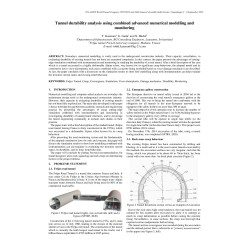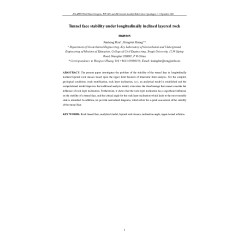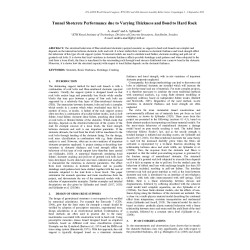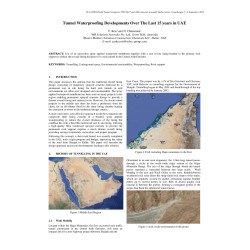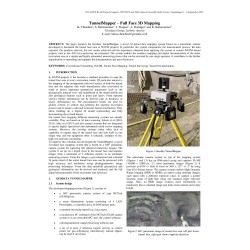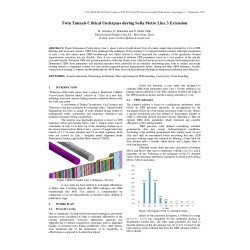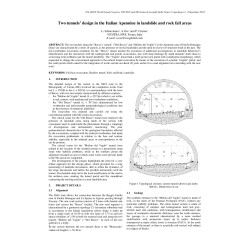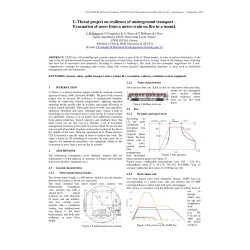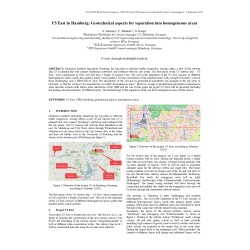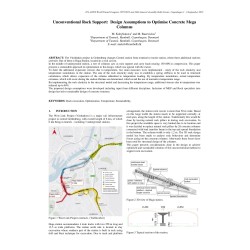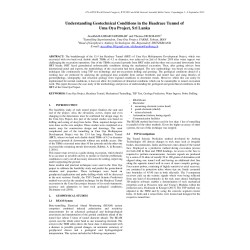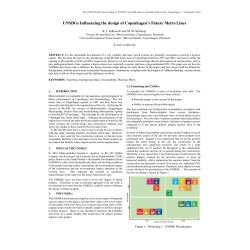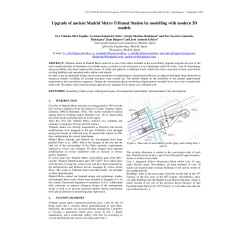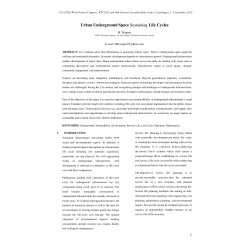No document
Search & filter
Search for a publication
Search & filter
Papers from WTC and ITA conferences have been made available as PDF documents.
ProceedingsThere are 1984 documents.
List of endorsed conferences
-
WTC
World Tunnelling Congress
-
Tunnel durability analysisusing combined advanced numerical modelling and
Abstract: Nowadays, numerical modelling is vastly used in the underground construction industry. Their capacity, nevertheless, in evaluating durability of existing tunnels has not been yet examined completely. In this context, the paper presents the advantages of cuttingedge simulation combined with instrumentation and monitoring in studying the durability of a road tunnel. After a brief description of...
0,00 € -
Tunnel face stability under longitudinally inclined layered rock masses
Abstract: The present paper investigates the problem of the stability of the tunnel face in longitudinally inclined layered rock masses based upon the upper limit theorem of kinematic limit analysis. For the complex geological conditions (rock stratification, rock layer inclination, i.e.), an analytical model is established and the computational model improves the traditional analysis model, overcomes...
0,00 € -
Tunnel segmental lining that enables rotational adjustment
Abstract: The sewer outfall project Riachuelo Lote 3 (Argentina) includes a diffuser section where vertical risers are installed by applying an innovative construction method: the “Riser Concept”. The risers are jacked upward from inside the tunnel through an aperture within the tunnel segmental lining. To ensure verticality of the installed riser, precise positioning of the segmental ring that contains...
0,00 € -
Tunnel Shotcrete Performance due to Varying Thickness and Bond to Hard Rock
Abstract: The structural behaviour of fibre reinforced shotcrete (sprayed concrete) as support in hard rock tunnels are complex and depends on the interaction between shotcrete, bolts and rock. It is here studied how variations in shotcrete thickness and bond strength affect the behaviour of this type of rock support system. Numerical models are used to simulate bond failure, shotcrete cracking and...
0,00 € -
Tunnel Waterproofing Developments Over The Last 15 years in UAE
Abstract: Use of an innovative spray applied waterproof membrane together with a cast in-situ lining bonded to the primary rock support to reduce the overall lining thickness for a rock tunnel in the United Arab Emirates.
0,00 € -
TunnelMapper - Full Face 3D Mapping
Abstract: The paper presents the Geodata TunnelMapper, a novel 3d tunnel face mapping system based on a panoramic camera developed to document the tunnel face area in NATM projects. In particular, the system components, the measurement process, the data acquired, the products derived, the test results achieved and the experience obtained from applying the system at current NATM tunnel projects such as...
0,00 € -
Twin Tunnels Critical Underpass during Sofia Metro Line 3 Extension
Abstract: Project Extension of Sofia metro, Line 3, phase I, aims to build almost 8 km of a metro single tube excavated by a 9.4 m EPB Machine and seven new stations. TBM drive challenged the underpass of two existing 5.2 m internal diameter tunnels with tight overburden of only 1.4 m; few meters prior TBM breakthrough into Metro Station 8, which increased the complexity of the operations. Ground...
0,00 € -
Two tunnels’ design in the Italian Apennine in land slide and rock fall areas
Abstract: The two tunnels along the "Bocco’s variant" (“Del Bocco” and “Mulino del Vaglio”) in the Apennine area of Emilia Romagna (Italy) are characterized by a series of aspects, as the presence of several landslides and the need to recover of structures built in the past. The low-overburden excavation condition for the “Bocco” tunnel needed the execution of additional investigations to landslide...
0,00 € -
U-THREAT - Underground Transport Hub Resilience to Ensure
Abstract: To face important traffic issues, large cities and metropolitan areas rely on the metro networks as the backbone of citizens’ mobility. Although underground transport is gaining popularity, it is also exposed to diverse threats, such as fires, explosion or technical failure, which can lead to great impairments. In the U-THREAT project, the first objective is to identify the possible terroristic...
0,00 € -
U-Threat project on resilience of underground transport -
Abstract: CETU led a 3D modelling and scenario analysis study, as part of the U-Threat project, in order to address deficiencies in the state of the art and operational measures around the evacuation of users from a train on fire in a tunnel. Some of the findings were surprising and have led to innovative new proposals, including in relation to walkways. The study has also prompted suggestions for a new,...
0,00 € -
U5 East in Hamburg: Geotechnical aspects for separation into homogeneous areas
Abstract: Germanys northern metropole, Hamburg, has big plans to alleviate traffic congestion. Among others, a new 20 km subway line U5 is planned that will connect Hamburg's northwest and northeast with the city center. The first phase of the U5 subway line – U5 East– were commenced in 2021 and will have a length of around 6 km. The soil in the alignment of the U5 East consists of different...
0,00 € -
UnconventionalRock SupportDesign Assumptions to Optimise Concrete Mega
Abstract: The Västlänken project in Gothenburg changes Central station from terminal to transit station, where three additional stations are built. One of them is Haga Station, located in a rock cavern. In the middle of underground station, a row of columns acts as rock support and carry loads nearing 150 MN in compression. This paper presents a sustainable approach to optimization in the design, which...
0,00 € -
Understanding Geotechnical Condition s in the Headrace Tunnel ofUma Oya Project, Sri Lanka
Abstract: The breakthrough of the 15.4 km Headrace Tunnel (HRT) of Uma Oya Multipurpose Development Project, which was excavated with two hard rock double shield TBMs of 4.3 m diameter, was achieved on 2nd of October 2019 after water ingress was challenging the excavation operations. One of the TBMs excavated upwards from HRT outlet and the other one excavated downwards from HRT Intake. HRT faced...
0,00 € -
UNSDGs Influencing the design of Copenhagen’s Future Metro Lines
Abstract: For the sustainable development of a city, mobility and mass transit systems are generally recognized as having a positive impact. This has been the case for the introduction of the M1/M2 metro lines in Copenhagen between 1997 and 2002, and more recently the opening of M3 and M4 in 2019 and 2020, respectively. However, we also need to acknowledge that the development of infrastructure, such as...
0,00 € -
Upgrade of ancient Madrid Metro Tribunal Station by modelling with modern 3D
Abstract: Tribunal station of Madrid Metro network is one of the oldest included in the accessibility upgrade program and one of the most complicated due to limitations of available space at surface as well as because it is an interchange station for lines 1 and 10. Interchange and accessibility have been improved by means of shafts and galleries at different levels which have been excavated in most...
0,00 € -
Urban Underground Space Sustaining Life Cycles
Abstract: It is common sense that urbanization is squeezing surface space. There is underground space usage the resilient and sustainable alternative. Economic development depends on infrastructure growth. Underground infrastructure enables development of smart cities. Major metropolitan urban centers across the globe are dealing with issues such as commuting disconnects and overburdened surface...
0,00 €


